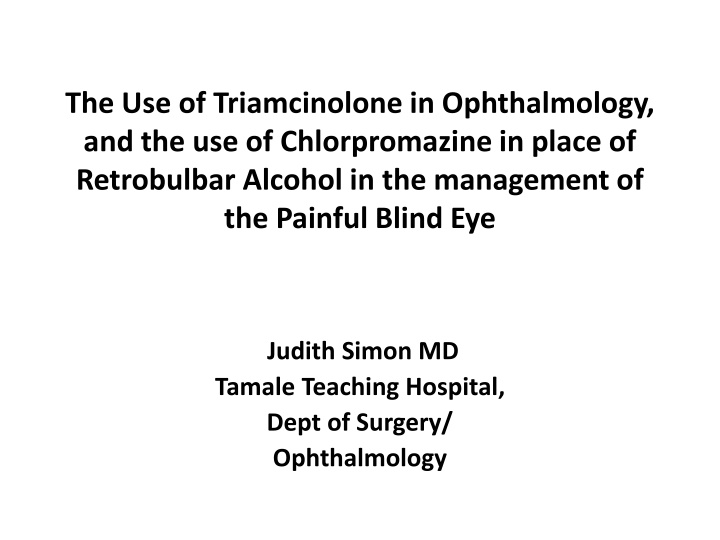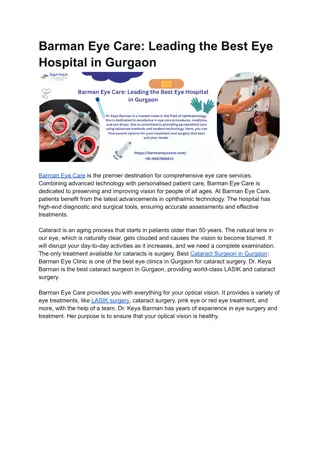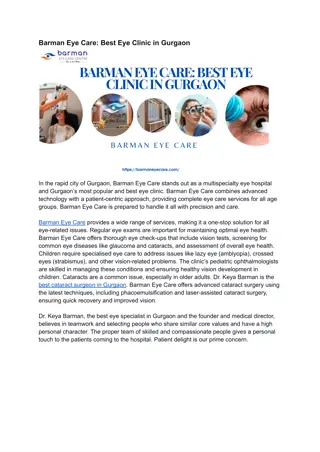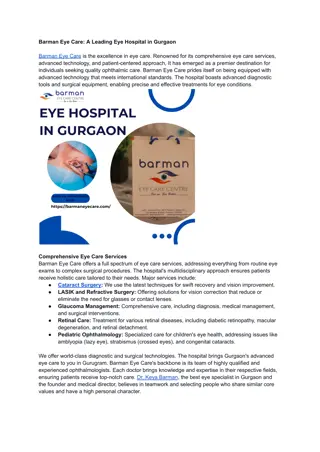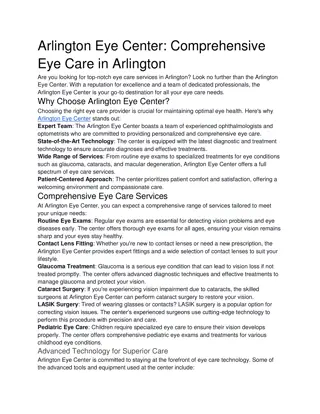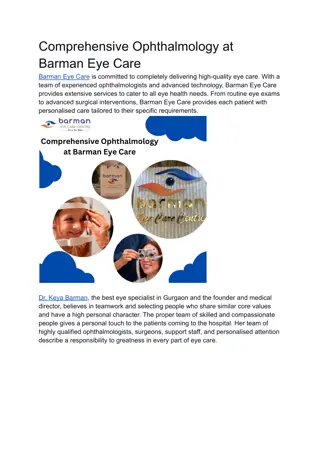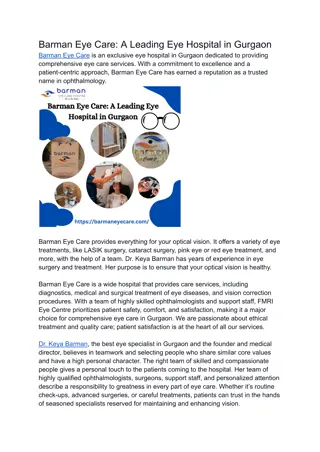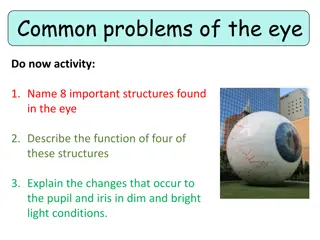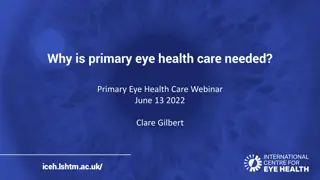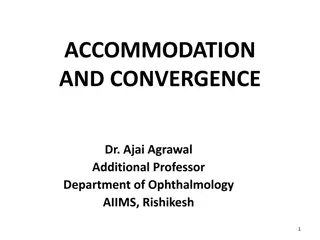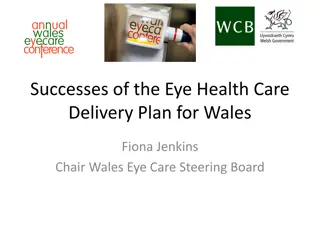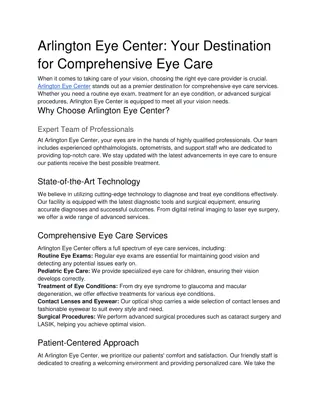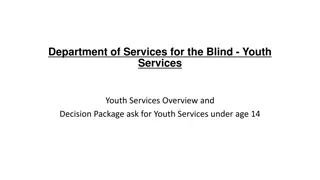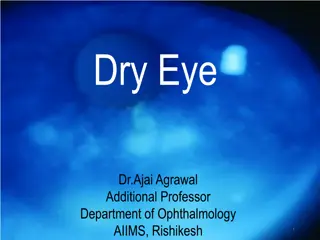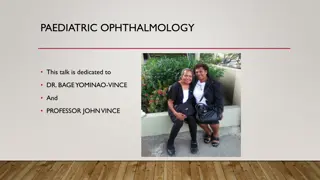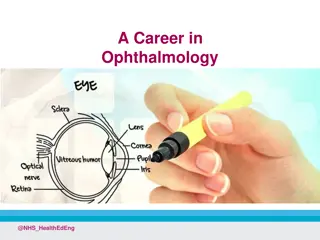Triamcinolone in Ophthalmology and Chlorpromazine for Painful Blind Eye
Triamcinolone is a potent synthetic corticosteroid used orally, by injection, inhalation, or topically for various eye conditions. Triamcinolone Acetonide, a more potent form, is commonly used in ophthalmology to manage inflammation. Chlorpromazine is suggested as an alternative to Retrobulbar Alcohol for painful blind eyes. Dosages and durations for administering Triamcinolone are outlined, along with potential side effects and indications for use.
Download Presentation

Please find below an Image/Link to download the presentation.
The content on the website is provided AS IS for your information and personal use only. It may not be sold, licensed, or shared on other websites without obtaining consent from the author.If you encounter any issues during the download, it is possible that the publisher has removed the file from their server.
You are allowed to download the files provided on this website for personal or commercial use, subject to the condition that they are used lawfully. All files are the property of their respective owners.
The content on the website is provided AS IS for your information and personal use only. It may not be sold, licensed, or shared on other websites without obtaining consent from the author.
E N D
Presentation Transcript
The Use of Triamcinolone in Ophthalmology, and the use of Chlorpromazine in place of Retrobulbar Alcohol in the management of the Painful Blind Eye Judith Simon MD Tamale Teaching Hospital, Dept of Surgery/ Ophthalmology
Triamcinolone It is a long-acting synthetic corticosteroid Can be given: Orally Injection Inhalation, Topically
Triamcinolone Acetonide More potent type of Triamcinolone, 8x more potent than Prednisolone It is a depot steroid, meaning it stays in the tissues for an extended period
Triamcinolone Acetonide Concentration: 40 mg/cc Brand name: Kenalog Marketed mainly for intraarticular use given for arthritis Available in most pharmacies Price: 10 GhC for generic, 14-20 GhC for brand Milky solution, shake well to homogenize
Dosage Retroseptal: 1 cc Subcutaneous: As much as you can inject Subconjunctival: As much as you can inject- usually 0.2-0.3 cc Supratarsal: As much as you can inject - - usually 0.1-0.2 cc
Duration Retroseptal: 3 months Subcutaneous: 1-3 weeks Subconjunctival: 5-7 days Supratarsal: 5-7 days Can be seen as white residue as long as it is there except for retroseptal Can be repeated as needed
Side-effects IOP rise can be treated with antiglaucoma medications Only temporary Leaves white residue subconjunctival warn patient. It disappears in 1-2 weeks Can leave permanent depigmentation on skin of black people-warn patient ahead of time
Indications: Any condition which requires prolonged and/or strong steroid use Can obviate systemic Prednisolone therapy much less side-effects
Indications for retroseptal triamcinolone:
Posterior Uveitis - Caused by toxoplasma, or anything else
Complicated cataract surgery-after PC rupture or ICCE for dislocated cataract
Trabeculectomy or combined SICS/Trabeculectomy
Contraindications for retroseptal use Known steroid responders Patients with poorly controlled, advanced or end-stage glaucoma Herpes Simplex stromal keratitis or keratouveitis without added Acyclovir the epithelial disease can reactivate
Indications for subconjunctival and/or supratarsal injection - For stage IV allergic conjunctivitis
Subcutaneous use For chalazion For keloids For any kind of scar tissue Be aware: It might cause skin depigmentation in black people
Keloid before and after Triamcinolone injection
Chlorpromazine in place of Retrobulbar Alcohol for the Management of the Painful Blind eye
Chlorpromazine A major tranquillizer and antiemetic Easily available, covered by NHIS Kills the pain fibers and the optic nerve Works about 80% of the time Effect can wear off in a few years, can be repeated In studies it is shown to be similar or more effective than alcohol
Mode of administration Injection is 25mg/cc, 2 cc vial Mix with 2cc of 2% Lidocaine and 2cc of Dexamethasone Give the 6cc mixture retrobulbar Give cycloplegics, steroid eyedrops and pain- killers for a week
Warn patient: Sight will NOT return !!! Remaining small vision will be lost !!! Pt will be sleepy for 2 hours give only if with relative, let PT sleep outside the clinic or go home fast Will have swelling of lids and conjunctiva for a few days Pain will wear off in 1-2 weeks
Side-effects Severe periocular inflammation Resolves in 2-3 weeks, reassure patient, can give po steroids
Consent form Important to get PT might get upset about vision not returning MAKE SURE YOU INJECT THE CORRECT EYE!!!
